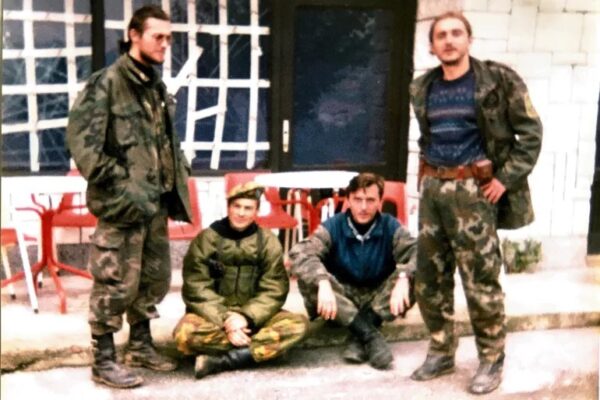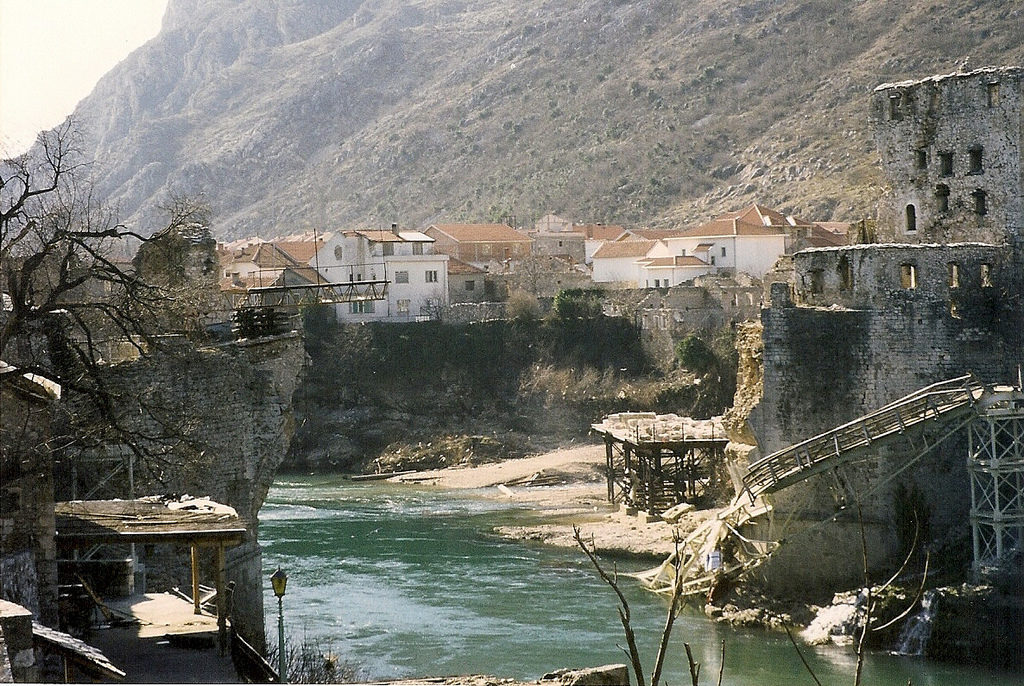The second siege of Mostar: June 1993 – April 1994.
With plenty of help from the Croats, Mostar survived the JNA and the first siege but the Croatians had their own agenda. They wanted Bosnia and Herzegovina to be simultaneously a military ally and a diplomatic victim.┬ĀPredictably, only a few months after pushing the Serbs away from Mostar, relations between the “allies” had begun to deteriorate.
From Zagreb, President Tu─æman was putting heavy pressure on his Bosnian counterpart President Alija Izetbegovi─ć to agree form a union between Croatia and B&H. Izetbegovi─ć, of course, wanted to keep B&H independent and free from coerced alliances with either Croatia or Serbia either of which would essentially strip B&H of all the territory in Herzegovina as well as the current Republika Srpska and would make the return of refugees nearly impossible.
Internally, some Bosnian Croats in the government were aligned more closely with Tu─æman than they were with the nascent B&H government. One of them, Minister of Defense Jerko Doko, prioritized weapons going to the HVO rather than the Bosnian forces. Another, Mate Boban, under cover of a U N arms embargo, blocked a delivery of arms secretly purchased by the government in Sarajevo from the former Yugoslavia.
On 3 July 1992, the declaration came forth formally establishing the Croatian Community of Herzeg-Bosnia. Controlling most of Herzegovina, the Croats attempted to form a de facto government establishing control over the police and army mainly by purging many of the Bosniaks that had been in the HVO and by taking control of the education system. In this territory, which included a number of areas that were majority Bosniak, they allowed only Croatian to be spoken, the Croatian kuna became the only accepted currency, and only the Croatian flag could be flown. Now backed into a difficult position, Izetbegovi─ć adopted a two-pronged approach in his effort to preserve the sovereignty of B&H.
First, on 21 July he signed the Agreement on Friendship and Cooperation between Bosnia and Herzegovina and Croatia that established a measure of military cooperation between Bosnian and Croatian forces. The most practical effect was that the Bosnian army continued receiving weapons through Croatia despite the arms embargo.

[Image of ARBiH Soldiers from Aljazeera].
Still, the relationship was fractious and, although Bosniaks were being purged from the HVO, the Bosnian government had little choice but to accept HVO as an integral part of the Bosnian armed forces.
The other remaining tactic for Izetbegovi─ć, who saw his country beset by the Orthodox Serbs on his north and east and the Catholic Croats from the south, was to emphasize the Islamic character of his beleaguered country. By October 1992, the situation had turned into a full-fledged war between the erstwhile allies and Bosniak forces loyal to Izetbegovi─ć. These forces had now been reinforced by mujahedin volunteers from several Islamic countries and fully engaged the HOV forces backed by the Croatian Army. Of course the West (meaning the rest of Europe and the U S) reacted with predictable horror at the presence of mujahedin.
Fighting continued throughout the winter and spring spreading throughout the region and by mid-April 1993, Mostar had essentially again become a divided city. As the photo shows, with the Stari Most standing as the only remaining bridge over the Neretva River, that divide would soon become literally true.

[I located this photo on ch2mhillblogs.com].
The western side of the Neretva River was dominated by HVO forces while the Army of the Republic of Bosnia and Herzegovina (ARBiH) held sway on the riverŌĆÖs eastern side. A major battle began on the morning of 9 May 1993 and, as is often the case in the fog of war, each side blamed the other for launching the attack. After the war, however, the ICTY during its trial of the HVO leadership concluded that the HVO was responsible for launching the attack.
The fighting escalated over the next month and by early June, the HVO controlled most of the city. At the end of the month the ARBiH launched a counterattack and recaptured portions of the city, after which, both sides settled down and turned to shelling and sniping at each other. However, the HVO armed with superior heavy weaponry caused severe damage to eastern Mostar.
The HVO held much of eastern Mostar under siege from June 1993 through April 1994. During this time, according to the findings of the ICTY, the Croatian backed HVO launched over 100,000 shells on east Mostar with casualties that included civilians and representatives of a number of international organizations. The HVO at some times impeded and at other times entirely cut off the provision of humanitarian aid to a city with limited access to food, water, electricity, and medical care.
It was also during this time, on 8 November 1993, that the HVO began its shelling of the Stari Most – the only crossing remaining after the 1992 siege by the JNA. Finally capitulating to what must have seemed inevitable, on 9 November the exquisite bridge that had stood for 427 years crumbled into the river below.
Ultimately, the ICTY convicted six leaders of the HVO of war crimes and crimes against humanity and still, at the time, we in the west were more than 18 months away from any meaningful intervention.
As for our group, we completed our tranquil ride and arrived at our hotel in the center of Sarajevo late in the afternoon where, after checking in, we walked to a local restaurant for a dinner that was also described as traditional.┬Ā My notes say, except for the homemade cherry brandy, the meal was neither exceptional nor memorable unlike the rest of our stay in this special city.